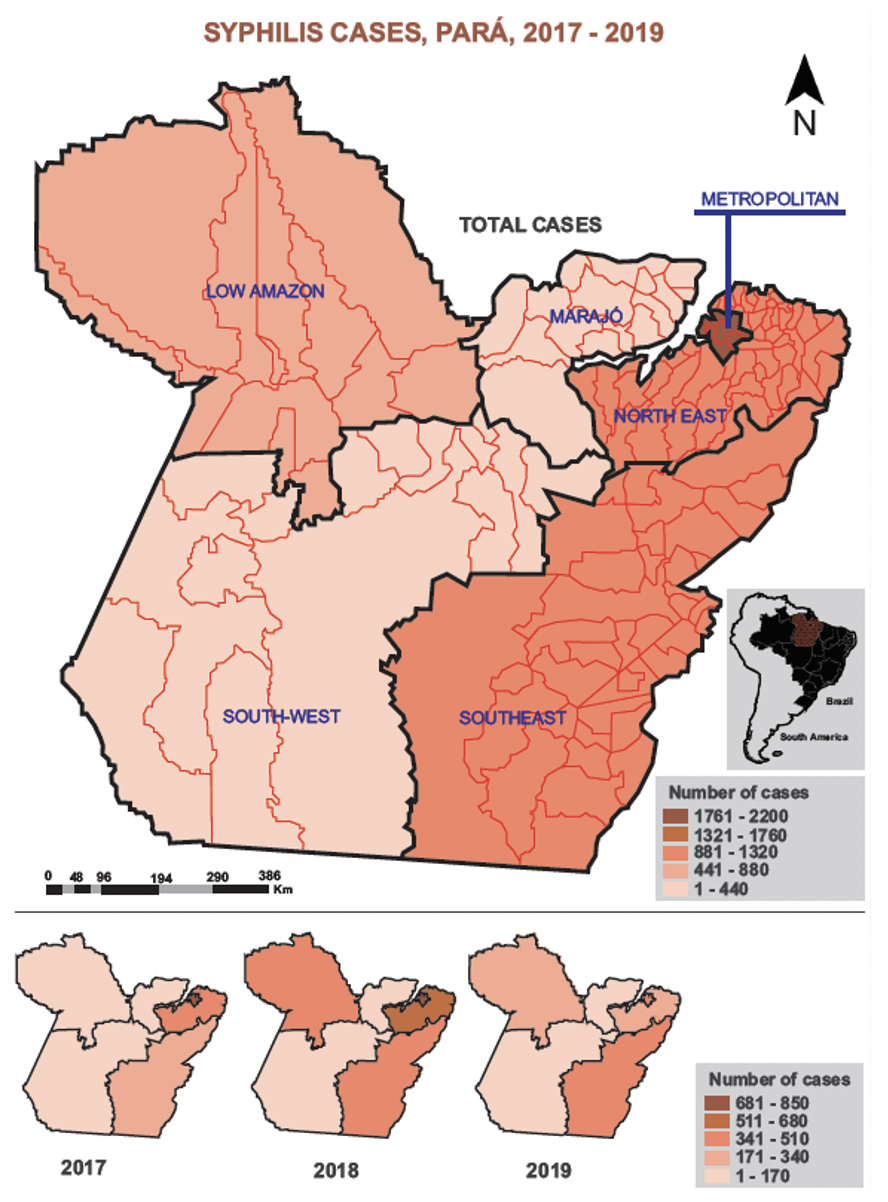Acquired Syphilis: epidemiological profile of cases in state of Pará from 2017 to 2019
Main Article Content
Abstract
Objective: To quantify patients diagnosed with acquired syphilis and the prevalence of the disease in the state of Pará, Brazil, from January 2017 to June 2019, in addition to characterizing the demographic aspects of patients included in the sample. Methods: observational, descriptive and cross-sectional study, conducted by reviewing the database of the Notifiable Diseases Information System made available by the State Health Department of Pará, of reported cases of acquired syphilis, in the defined period. This study included patients of both sexes, aged 18 years or older, who had acquired syphilis and were notified. Results: 5,620 cases of acquired syphilis were reported, of which the majority were male (n = 3,229; 57.45%), mixed race (n = 4,058; 72.2%), low education (n = 2,250; 40%) and in the young adult range (18–30 years; n = 2,514; 44.74%). The highest concentration of cases was observed in the metropolitan mesoregion of Belém and the Lower Amazon. Conclusions: Acquired syphilis is still prevalent and is characterized as a public health problem. Epidemiological surveillance needs to be constant, and more efficient public policies need to be employed in primary care to reduce the number of cases and make early diagnoses with appropriate treatment.
Article Details
Authors maintain copyright and grant the HSJ the right to first publication. From 2024, the publications wiil be licensed under Attribution 4.0 International 
 , allowing their sharing, recognizing the authorship and initial publication in this journal.
, allowing their sharing, recognizing the authorship and initial publication in this journal.
Authors are authorized to assume additional contracts separately for the non-exclusive distribution of the version of the work published in this journal (e.g., publishing in an institutional repository or as a book chapter), with acknowledgment of authorship and initial publication in this journal.
Authors are encouraged to publish and distribute their work online (e.g., in institutional repositories or on their personal page) at any point after the editorial process.
Also, the AUTHOR is informed and consents that the HSJ can incorporate his article into existing or future scientific databases and indexers, under the conditions defined by the latter at all times, which will involve, at least, the possibility that the holders of these databases can perform the following actions on the article.
References
Brasil. Ministério da Saúde. Secretaria de Vigilância em Saúde. Boletim epidemiológico de sífilis [Internet]. Brasília, DF: Ministério da Saúde; [published 2019 Oct 24; cited 2021 Feb 03]. 44 p. Avaiable from: http://www.aids.gov.br/pt-br/pub/2019/boletim-epidemiologico-sifilis-2019
Brasil. Ministério da Saúde. Secretaria de Vigilância em Saúde. Sífilis: Estratégias para diagnóstico no Brasil [Internet]. Brasília, DF: Ministério da Saúde; 2010 [cited 2021 Feb 03]. 100 p. Avaiable from: http://bvsms.saude.gov.br/bvs/publicacoes/sifilis_estrategia_diagnostico_brasil.pdf
Matias MDP, Jesus AO, Resende RG, Caldeira PC, Aguiar MCF. Diagnosing acquired syphilis through oral lesions: the 12-year experience of an oral medicine center. Braz J Otorhinolaryngol. 2020;86(3):358-63. https://doi.org/10.1016/j.bjorl.2018.12.010 PMid:30956150 DOI: https://doi.org/10.1016/j.bjorl.2018.12.010
Lasagabaster MA, Guerra LO. Sífilis. Enferm Infecc Microbiol Clin. 2019;37(6):398-404. https://doi.org/10.1016/j.eimc.2018.12.009 PMid:30738716 DOI: https://doi.org/10.1016/j.eimc.2018.12.009
Reinehr CPH, Kalil CLPV, Reinehr VPH. Secondary Syphilis: The great imitator can't be forgotten. Rev Assoc Med Bras. 2017;63(6):481-3. https://doi.org/10.1590/1806-9282.63.06.481 PMid:28876421 DOI: https://doi.org/10.1590/1806-9282.63.06.481
Brasil. Ministério da Saúde. Secretaria de Vigilância em Saúde. Manual técnico para diagnóstico da sífilis. Brasília, DF: Ministério da Saúde; [published 2016 Oct 20; cited 2021 Feb 03]. 54 p. Avaiable from: http://www.aids.gov.br/pt-br/pub/2016/manual-tecnico-para-diagnostico-da-sifilis
Brasil. Ministério da Saúde. Secretaria de Vigilância em Saúde. Protocolo clínico e diretrizes terapêuticas para atenção integral às pessoas com infecções sexualmente transmissíveis [Internet]. Brasília, DF: Ministério da Saúde; [published 2015 Nov 13; cited 2021 Feb 03]; 120 p. Avaiable from: https://bit.ly/3oHFcwF
Brasil. Fundação Instituto Brasileiro de Geografia e Estatística (IBGE). Divisão regional do Brasil em mesorregiões e microrregiões geográficas (vol.1). Rio de Janeiro, RJ: IBGE; 1990 [cited 2021 Feb 03]. 135 p. Avaiable from: https://biblioteca.ibge.gov.br/visualizacao/livros/liv2269_1.pdf
Ayres M, Ayres Jr M, Ayres DL, dos Santos AAS. BioEstat 5.4 - Aplicações estatísticas nas áreas das ciências biológicas e medicas [Internet]. Belém, PA: Sociedade Civil Mamirauá - IDSM/ MCT/ CNPq; 2007 [cited 2021 Feb 03]. Avaiable from: https://bit.ly/3pF29Sm
Garbin AJI, Martins RJ, Belila NM, Exaltação SM, Garbin CAS. Reemerging diseases in Brazil: sociodemographic and epidemiological characteristics of syphilis and its under-reporting. Rev Soc Bras Med Trop. 2019;52:e20180226. https://doi.org/10.1590/0037-8682-0226-2018 PMid:30810654 DOI: https://doi.org/10.1590/0037-8682-0226-2018
Jain A, Mendiratta V, Chander R. Current status of acquired syphilis: A hospital-based 5-year study. Indian J Sex Transm Dis AIDS. 2012;33(1):32-4. https://doi.org/10.4103/0253-7184.93814 PMid:22529451 PMCid:PMC3326846 DOI: https://doi.org/10.4103/0253-7184.93814
Brasil. Ministério da Saúde. Secretaria de Vigilância em Saúde. Protocolo clínico e diretrizes terapêuticas para atenção integral às pessoas com infecções sexualmente transmissíveis. 2019; p 55-90.
Brasil. Instituto Brasileiro de Geografia e Estatística (IBGE). Características gerais dos domicílios e dos moradores: 2019 [Internet]. Rio de Janeiro: IBGE; 2020 [cited 2021 Feb 03; updated 2020 May 26]. Avaiable from: https://biblioteca.ibge.gov.br/index.php/biblioteca-catalogo?view=detalhes&id=2101707
Chile. Ministerio de Salud de Chile. Departamento de Epidemiologia. Situación epidemiológica de sífilis. Rev Chilena Infectol. 2018;35(3):284-96. https://doi.org/10.4067/s0716-10182018000300284 PMid:30534908 DOI: https://doi.org/10.4067/s0716-10182018000300284
Wong NS, Huang S, Zheng H, Chen L, Zhao P, Tucker JD, Yang LG, Goh BT, Yang B. Stages of syphilis in South China - a multilevel analysis of early diagnosis. BMC Public Health. 2017;17(1):135. https://doi.org/10.1186/s12889-016-4004-y PMid:28143448 PMCid:PMC5282730 DOI: https://doi.org/10.1186/s12889-016-4004-y
Sousa RAC, Marques ED, Frade PCR, Cordeiro ACC, Martins LC, Resque RL, et al. Syphilis among illicit drugs users in the State of Pará, Brazilian Amazon [Internet]. Chapter 1. Avid Science [Internet]. 2017 Jul 21. 27 p. Avaiable from: https://bit.ly/39HOuo3
Silva EC, Tupinambá MR, Silva FASD, Vieira JR, Borges SCR, Nascimento LS. Resultados de sorologia para casos de sífilis em campanha de município no norte do Brasil. Rev Pan-Amaz Saúde. 2016;7(1):39-43. https://doi.org/10.5123/S2176-62232016000100005 DOI: https://doi.org/10.5123/S2176-62232016000100005

